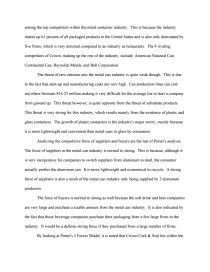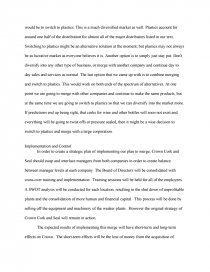Anylsis of Crown
Essay by review • February 6, 2011 • Research Paper • 1,723 Words (7 Pages) • 2,691 Views
Executive Overview
In April of 1957, when Crown Cork & Seal was on the edge of bankruptcy, John Connelly took over presidency with intent to save the company. By the end of 1957, Crown had "climbed out of the coffin and was sprinting." Connelly's unique leadership is what contributed to the success of Crown. In May of 1989, Connelly stepped down from his position as chairman appointing his long-time disciple William Avery as chief executive officer. Avery had plans to assess Connelly's long-followed strategy because of the industry changes that were taking place. Since Connelly got into the business in 1957, the metal can industry had been greatly redefined as both suppliers and customers of can makers moved into can-making themselves. With the changes that were taking place, Avery wondered if it would be a good idea for Crown to bid on all or part of Continental Can (one of their competitors), whose operations were up for sale. Avery was also faced with the decision to break Crown's tradition and increase its product line beyond the manufacture of metal cans and closures. Little growth potential was seen in the metal can industry, and plastics were forecasted as the growth segment for containers. Crown's competitors had been expanding aggressively in a variety of directions, and Connelly remained careful and thrived. Because Crown had done the same thing for so long, Avery wondered if it was time for them to change. If Crown acquired Continental Can Canada, Canada would become Crown's largest single presence outside of the U.S. and would double the size of Crown's domestic operations. However, most mergers in this industry had not worked out well, and Avery had concerns about taking two companies from completely different cultures and bringing them together.
Analysis
The use of Porter's 5 Forces Model gives an analysis of the industry for Crown Cork & Seal and an overview of where it is positioned within it. There is a strong competitive force among the top competitors within the metal container industry. This is because the industry makes up 61 percent of all packaged products in the United States and is also only dominated by five firms; which is very minimal compared to an industry as restaurants. The 4 rivaling competitors of Crown, making up the rest of the industry, include: American National Can, Continental Can, Reynolds Metals, and Ball Corporation.
The threat of new entrants into the metal can industry is quite weak though. This is due to the fact that start-up and manufacturing costs are very high. Can production lines can cost anywhere between $16-25 million making it very difficult for the average Joe to start a company from ground up. This threat however, is quite opposite from the threat of substitute products. This threat is very strong for this industry, which results mainly from the existence of plastic and glass containers. The growth of plastic containers is the industry's major worry; mainly because it is more lightweight and convenient than metal cans or glass by consumers.
Analyzing the competitive force of suppliers and buyers are the last of Porter's analysis. The force of suppliers in the metal can industry is normal to strong. This is because, although it is very inexpensive for companies to switch suppliers from aluminum to steel, the consumer actually prefers the aluminum can. It is more lightweight and economical to recycle. A strong force of suppliers is also a result of the metal can industry only being supplied by 3 aluminum producers.
The force of buyers is normal to strong as well because the soft drink and beer companies are very large and purchase a sizable amount from the metal can industry. It is also indicated by the fact that those beverage companies purchase their packaging from a few large firms in the industry. It would be a definite strong force if they purchased from a large number of firms.
By looking at Porter's 5 Forces Model, it is noted that Crown Cork & Seal lies within the five dominant firms of the industry. This indicates that the company does have the opportunity to compete and even become the leader of the industry. To be the leader; however, will depend on Crown's strategy.
Problem Statement
One problem that Crown Cork and Seal faces is that the industry is becoming more competitive through acquisitions and mergers. These acquisitions and mergers in the 1980s served to shift, as well as consolidate power, at the top of the county's leading manufacturers. Some of these acquisitions and mergers include such companies as American National Can and Continental Can, which are two major competitors for Crown Cork and Seal. Peter Kiewit Sons Inc. purchased Continental Group in 1984, and turned sales of 3.3 million in 1988.
Another problem serving Crown Cork and Seal is that the industry has become less dependent on can sales alone. They have diversified across the spectrum of rigid containers to supply all major end-use markets (food, beverages, and general packaging), others diversified into non-packaging businesses such as energy (oil and gas), and financial services. The product line of the worlds largest can maker, American National Can, is steel cans, glass containers, and caps and closures served the major beverage, food, pharmaceuticals, and cosmetics market. This goes to show that even the world's largest can maker doesn't solely rely on the sales of its cans.
Another reason why Crown Cork and Seal should not to depend on can sales alone is the rise of in-house manufacturing and plastics. Production of cans at "captive" plants-those producing cans for their own company use-accounted for approximately 25% of the total can output in 1989. Many brewers found it advantageous to invest in captive manufacturer because high-volume, single-label production runs made them more profitable. This trend is taking away a lot of business from the can manufacturer industry, weakening future growth potential. Plastics were also the growth leader in the 1980s. They went from 9% market share of the container market in 1980 to 18% in 1989.
Recommendations
Crown
...
...





